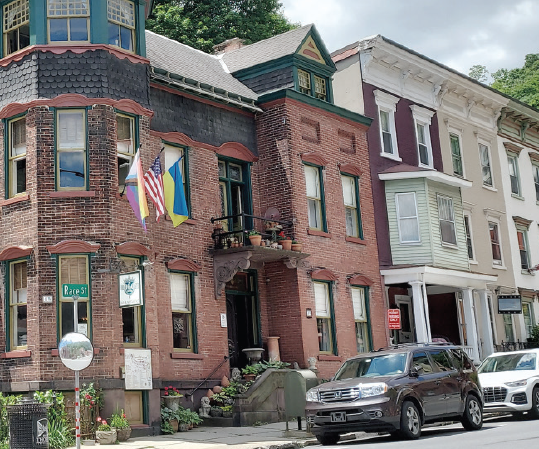If you don’t know it’s there, you won’t see it while driving around Lake Tahoe. Nestled on a coastal spur on the Nevada side sits Thunderbird Lodge, the home of “accidental” conservationist and multi-millionaire George Whittell, Jr. And that’s just the way he wanted it.
An Unplanned Legacy
Born in San Francisco in 1881, Whittell inherited his parent’s vast fortune, and was able to indulge in his dream of “never working a day in his life,” instead pursuing his love of adventure and the unusual, from running away to join the circus, to safaris in Africa, to serving as an ambulance driver in World War I. Exiting the stock market with $50 million just before the 1929 crash (equivalent to $4 billion today), he chose to move to Nevada to dodge California income and real estate taxes. It was with this decision that his unintentional Tahoe legacy begins.
By the early 1900s, Tahoe’s mountains had been logged to bare rock. Timber barons saw no value in the land and were eager to sell. With ready cash, and a desire for solitude, Whittell purchased 40,000 acres along 27 miles of shoreline extending from Incline Village to Zephyr Cove. Although he had originally planned to develop parts of the lake, he grew to see the worth of preserving the region, and resisted offers and demands, building an isolated summer retreat.
As time progressed, the state of Nevada felt that nobody should own so much land, and used eminent domain to take Sand Harbor. In 1960, he was pushed to sell 9,000 acres of property to developers who would create today’s Incline Village. Whittell was forced to sell off additional parcels over the years, until his death in 1969.
Acquired by Jack Dreyfus in 1972, much of the remaining 25,000 acres were sold to the Nevada State Parks and the US Forest Service, ensuring no further development. Dreyfus added to the building, but spent little time there. In 1993, he sold the Lodge in a complex government exchange in which the land went to the US Forest Service, and responsibility for the historic structures were taken on by the non-profit Thunderbird Lodge Preservation Society, which manages the property today.
The Lake Cottage
In 1936, construction of Thunderbird Lodge commenced. Whittell was a hands-on owner, constantly changing proposed designs, meticulous about detail. Completed in 1941, the Lake Cottage, as it was originally called, included six cottages built of native stone and timber. He explicitly wanted it to blend in with the natural surroundings. Some buildings were for his exotic animals collection, including elephants and a lion.
Built in the “Tudor Revival” style, gabled walls chiseled from mellowed stone sit under steeply sloped shake roofs. Hand-wrought ironwork lamps and fixtures accent carved wooden beams, stairs and railings glow golden in the ruddy sunlight bouncing through the diamond-paned windows that grant visitors a glorious view of Lake Tahoe.
The home is four stories, including the servants’ quarters in the basement. A ham radio, movie camera, a hydroelectric plant fed by an elaborate fountain, air conditioning, and an exercise machine reveal Whittell’s interest in (at the time) leading-edge technologies. An electronic intruder sensor-siren system and hidden passages, stairways, and cupboards reflect his passion for privacy; he was known to “disappear” from card games or his wealthy guests when he tired of them.
Stone pathways curl about the massive granite boulders and gardens, edging along the cove where boats docked and guests would swim, overlooked by a restored lighthouse. Stories say that Whittell would light its beacon so he could find his way back from visits around the lake.
Queen of the Lake
A twisting 600-foot underground tunnel extends from the main house to the boathouse. Out-of-work miners blasted the tunnel and the stone was used to build the pathways. In one chamber, a dancing devils fireplace grate likely gave eerie illumination to what is believed to be an opium den, a perfectly acceptable practice in the day. An unknown room, re-discovered after Whitell’s death, is an unfinished swimming pool. A worker died there in an accident, and Whittell chose to seal it off.
The beautifully maintained 55-foot long vintage 1940 Thunderbird Yacht personified Whittell’s love of technology and opulence. Crafted with Honduran mahogany, featuring a gleaming steel and chrome Duesenberg-styled exterior top cabin, the “Queen of the Lake” was designed by famed naval architect John L. Hacker explicitly for use on Lake Tahoe.
Nicknamed the “Castle in the Sky” by locals, the Lodge is now on the National Register of Historic Places. In addition to private and group tours, Thunderbird Lake Tahoe is popular to rent for parties, weddings, corporate events, school programs and more. Note that to visit, you have to take a shuttle bus that leaves from Incline Village; no private cars are allowed at the Lodge. thunderbirdtahoe.org.





